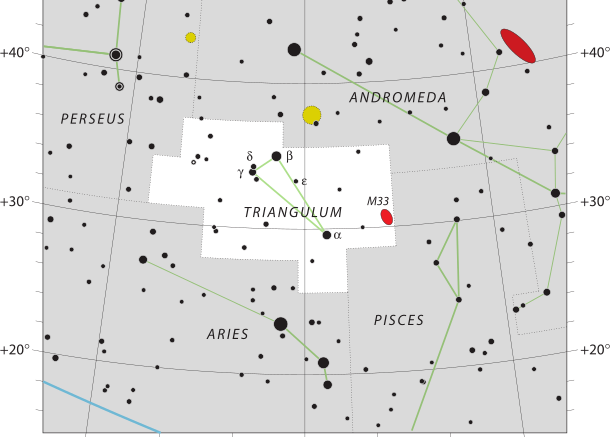Located in the northern sky, the constellation Triangulum is small in size, with a name in Latin meaning Triangle. This name of “triangle”, derives from the three brightest stars, which form a long and narrow triangle. Known to the ancient Babylonians and Greeks, Triangulum was one of the 48 constellations listed by the 2nd century astronomer Ptolemy. The celestial cartographers Johann Bayer and John Flamsteed catalogued the constellation’s stars, who gave 6 of them Bayer designations.
The base of the triangle is made up of white stars Beta and Gamma Trianguli, as the apex is the yellow-white Alpha Trianguli. Iota Trianguli is a notable double star system, and there are three star systems with known planets located in Triangulum. The constellation contains several galaxies, the brightest and nearest of which is the Triangulum Galaxy, otherwise known as Messier 33. The first quasar ever observed, 3C 48, also lies within the boundaries of Triangulum.
Triangulum covers 132 square degrees and 0.320% of the night sky, which means that the constellation ranks 78th of 88 constellations in regards to size.
| Applicable Information | |
| Visibility In Pacific Northwest | July To February |
| Best Times To View | December |
| Right Ascension | 5h |
| Declination | −65° |
| Area | 132 square degrees |
| Main Stars | 3 |
| Brightest Object | β Tri |
| Meteor showers | 0 |
| Messier objects | 1 |
| Neighboring Constellations | Andromeda, Pisces, Aries, Perseus |
History
Babylonian star catalogues had Triangulum and Gamma Andromedae form the constellation known as MULAPIN or “The Plough”. This is notable because it is the first constellation presented on a pair of tablets containing canonical star lists that were compiled around 1000 BC.
The Ancient Greeks called Triangulum Deltoton, as the constellation resembled an upper-case Greek letter delta. It was transliterated by Roman writers, and later Latinised as Deltotum.
It was also called Sicilia, because the Romans believed Ceres, patron goddess of Sicily, begged Jupiter to place the island in the heavens. Som Greek astronomers such as Hipparchos and Ptolemy called it Trigonon, and later, it was Romanized as Trigonum. Other names referring to its shape include Tricuspis and Triquetrum.
In Chinese astronomy, Gamma Andromedae and neighboring stars including Beta, Gamma and Delta Trianguli were called Teen Ta Tseang Keun, representing honor in astrology and a great general in mythology.
Stars
Bayer catalogued five stars in the constellation, giving them the Bayer designations Alpha to Epsilon. John Flamsteed added Eta, Iota and four Roman letters; of these, only Iota is still used as the others were dropped in subsequent catalogues and star charts. Flamsteed gave 16 stars Flamsteed designations, all of which are still used but numbers 1 and 16.
The Triangulum Galaxy, also known as Messier 33, was discovered by Giovanni Battista Hodierna in the 17th century. A distant member of the Local Group, it is about 2.3 million light-years away, and at magnitude 5.8 it is bright enough to be seen by the naked eye under dark skies. Being a diffuse object, it is challenging to see under light-polluted skies, even with a small telescope or binoculars, and low power is required to view it. It is a spiral galaxy with a diameter of 46,000 light-years and is thus smaller than both the Andromeda Galaxy and the Milky Way.
Within the galaxy, NGC 604 is an H II region where star formation takes place. There are several NGC galaxies of visual magnitudes 12 to 14, the largest of which include NGC 925 spiral galaxy and NGC 672 barred spiral galaxy.
Make sure to check out other articles on the site, including a brief introduction to constellations, other constellation articles, and more!

Be the first to comment on "Triangulum"